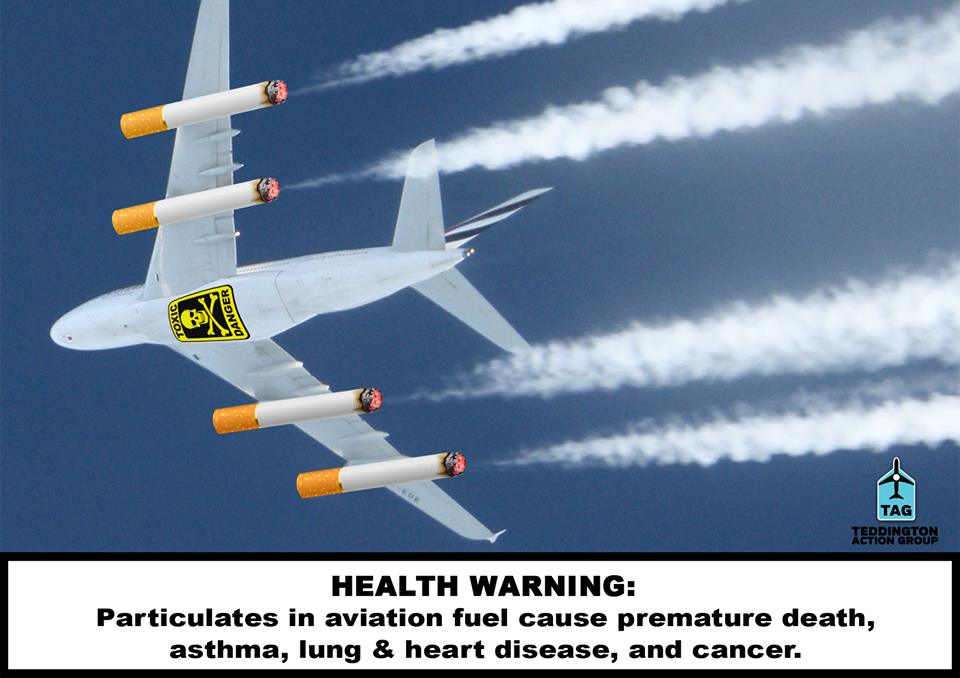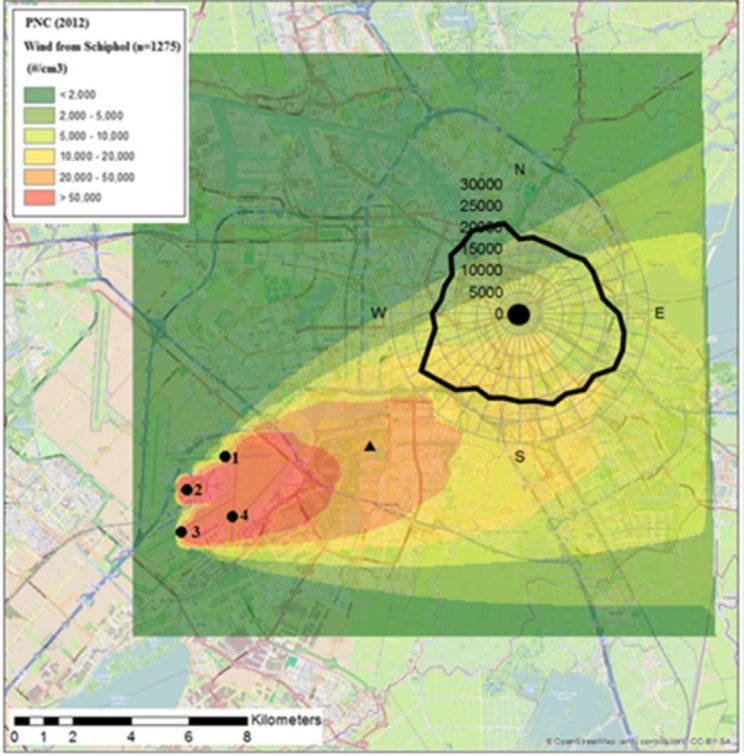
Both the Department for Transport and Heathrow Airport state that aircraft do not cause emissions harmful to humans on the ground when the aircraft is above 100 metres, which is well within 2 kilometres from the boundary of the airport. Heathrow gave evidence on this to the Transport Committee of the House of Commons [ link – see paras 1.52 and 1.53 ] and the Department for Transport gave evidence on this to the Court in the Judicial Review application [ ref to Defra 2004 report now taken down but still referred to by Heathrow in their Air Quality Report of 2014 at section 2.1.1 – link here ]. Heathrow state in the Local Air Quality Overview, part of their expansion consultation prior the Development Consent Order application, that:
“Aircraft flying into and out of the airport do not have a significant effect on air quality in the local area. This is because aircraft are so high that emissions are dispersed before reaching on the ground” [ link here. Heathrow also state this in their Preliminary Environmental Information Report – Non Technical Summary dated the 18th June 2019]
We say that this is quite patently untrue and there is plenty of evidence to support this. In their Preliminary Environmental Information Report, Heathrow have produced an out of date research report that excludes the results of the latest research. The Department of the Environment Fisheries and Rural Affairs (DEFRA) refer to research showing that both particulates and nitrogen oxides can travel downwind for a very substantial distance (up to 40 kilometres). The Air Quality Expert Group of DEFRA say in their report of 2018 entitled “Ultrafine Particles (UFP) in the UK” that at “a location such as Heathrow Airport, where aircraft tend to approach the airport from the east (flying over the London conurbation), there is potential for considerable exposure to UFP from aircraft”.
UFPs are minute particles emitted into the atmosphere from combustion. They are described by DEFRA as “Emissions of UFP arise primarily from combustion sources and especially transport-related sources which burn sulphur-containing fuels. Emissions from road transport affect all areas with major roads, emissions from shipping are important on the main shipping routes, and emissions from aviation are significant in the vicinity of major airports”.
Whether Heathrow’s production of an out of date research report is deliberate is a matter of conjecture, but as the Heathrow Preliminary Environmental Information Report is dated 5 years after the first report on the effects of emissions transfer by wind and 1 year after the DEFRA report on ultra fine particles endorsing the wind transmission research findings, it seems inconceivable that Heathrow do not know of the latest research.
UFPs are particularly harmful, penetrating deep into the lungs and from there into the body – something acknowledged by DEFRA in its report. Particulates and Nitrogen Dioxide together can be very harmful and affect breathing. Together they cause more than 28,000 deaths per year.
Particulates can be divided into three categories:
- PM10s: These are described by the rules as “particulate matter which passes through a size-selective inlet …… at 10 μm aerodynamic diameter” (μm stands for a micrometre which is one millionth of a metre so a PM10 filter is 10 millionths of a metre). These are termed relatively course particles
- PM2.5s: These are “particulate matter which passes through a size-selective inlet ….at 2.5 μm aerodynamic diameter”. These are termed fine particles
- “Ultrafine particles” are defined by DEFRA as “as those [particulate matter] with one dimension less than 100 nanometres”. A nanometre is one thousandth of a micrometre or one billionth of a metre. As they pass through the filter of a PM2.5, they are, by definition, PM2.5s under the EU Regulations.
The Air Quality Expert Group of DEFRA refer to three detailed empirical studies [there are a number of other investigative reports as well]:
Firstly “Hudda et al. [2014] measured concentrations of PN [Particulate Number] downwind of Los Angeles International Airport (LAX) using a mobile monitoring approach and detected at least a 2-fold increase in PN concentrations over baseline PN concentrations during most hours of the day, in an area of about 60 km2 that extended to 16 km downwind, and a 4- to 5-fold increase to 8–10 km downwind.”

Secondly “Keuken et al. (2015) made measurements at Adamse Bos, located 7 km from Schiphol, and in 2012 at Cabauw, a regional background site 40 km south of Schiphol. PNC increased during periods in which the wind direction was from Schiphol: at Cabauw by 20% and at Adamse Bos by a factor of three, from 14,100 (other wind directions) to 42,000 cm−3 between 06.00 and 23.00. The size distribution of Schiphol-related PNC was dominated by ultrafine particles, ranging from 10 to 20 nm”

Thirdly “Riley et al. (2016) measured downwind of two large airports in the USA: LAX (Los Angeles) and Hartsfield-Jackson International Airport (ATL – Atlanta, GA), using a mobile monitoring platform. Riley et al. (2016) found a 3–5-fold increase in UFP concentrations in transects under the landing approach path to both airports, relative to surrounding urban areas with similar ground traffic characteristics.”

In the conclusion to the DEFRA report, it is said:
“Research from mainland Europe and North America indicates that aviation emissions can have an appreciable impact upon particle number concentrations within tens of kilometres of major airports.”
The Hudda Report also found that “Over large areas downwind of LAX [Los Angeles Airport], concentrations of pollutants other than PN were also elevated. Figure 5(a)−(c) show nearly indistinguishable spatial patterns for PN [particulates], BC [black carbon], and NO2 concentration measured simultaneously at distances of 9.5−12 km from LAX. This suggests a common source for these pollutants, although the BC concentration increases were not large when compared to PN and NOx, about 0.5−1 μg/m3 at 8−10 km downwind.”
Following these three reports Hudda and others completed a study at Boston Logan Airport in which they found again that ultra fine particles could travel substantial distances. In the introduction they say:
“Aircraft engine exhaust emissions are a significant source of ultrafine particles (UFP; aerodynamic diameter <100 nm) and can cause several-fold increases in ground-level particle number concentrations (PNC) over large areas downwind of airports. The spatial extent and magnitude of the impact varies depending on factors including wind direction and speed, runway use pattern, and flight activity but encompasses large populations in cities where airports are located close to the urban residential areas. For example, in Amsterdam, PNC (a proxy for UFP) were found to be elevated 7 km downwind of Schiphol Airport while in Los Angeles, PNC were reported to be elevated 18 km downwind of Los Angeles International Airport. Thus, it is important to characterize aviation-related UFP.”
Under infiltration they comment on outdoor concentrations shown by their results
“Outdoor concentrations during impact-sector winds from 1900 h to as late as midnight on Nov 6–7, 2012 were ∼40 000 particles/cm3 but then decreased to as low as 2000 particles/cm3 during the hours of low flight activity at the airport (LTO decreased from 32 h–1 to 2.8 h–1 during 1900–0000 h to 0000–0500 h)”.
Ying Zhou et al reported in June 2019 that in China civil aircraft emissions during landing and takeoff are important air pollutant sources, but have been given insufficient attention stating of the estimation and modelling of aircraft emissions that:
“Substantial monthly, daily and hourly variations of emissions due to the flight schedule as well as mixing layer height were calculated. Large differences were found between the new estimation and emissions calculated based on traditional method. Compared with the emissions estimated based on default parameter obtained from International Civil Aviation Organization, the average difference of annual emission among airports with new estimation for various pollutants was approximately 30.3% in climb mode and 81.4% in approach mode”
A multidisciplinary team, led by lung researcher Marianne Geiser of the Institute of Anatomy at the University of Bern, together with colleagues from Empa Dübendorf and the University of Applied Sciences and Arts Northwestern Switzerland (FHNW), has shown in a report in May 2019 that primary soot particles from kerosene combustion in aircraft turbine engines also cause direct damage to lung cells and can trigger an inflammatory reaction if the solid particles — as simulated in the experiment — are inhaled in the direct vicinity of the engine. The researchers demonstrated for the first time that the damaging effects also depend on the operating conditions of the turbine engine, the composition of the fuel, and the structure of the generated particles. The present study was published in the journal Nature Communications Biology.
The Mobile ObserVations of Ultrafine Particles (MOV-UP) of Washington state university study finalised in December 2019 analyzed the potential air quality impacts of ultrafine pollution particles from aircraft traffic within 10 miles of the airport in the direction of aircraft flight on communities near and underneath Seattle-Tacoma International Airport (Sea-Tac) flight paths. The study found that communities underneath and downwind of jets landing at Sea-Tac Airport are exposed to a type of ultrafine particle pollution that is distinctly associated with aircraft.
This two-year study, which ended in December 2019, was funded by the Washington State Legislature to assess ultrafine pollution particles within 10 miles of the airport in the direction of aircraft flight. The study was led by the UW Department of Environmental & Occupational Health Sciences and the Department of Civil and Environmental Engineering.
According to the Local London Air Quality Monitoring, NO2 in 2013, updated in 2016, exceeded a concentration of 43 μg/m3 and PM2.5s exceeded 15 μg/m3. NO2 should have been below 40 μg/m3. PM2.5s are required to be reduced over time.
The effect of exposure to particulate matter and NO2 should not be underestimated. The Royal College of Physicians in its report of February 2016 entitled “Every breath we take: the lifelong impact of air pollution” stated that:
“Air pollution, to which we are all exposed to a lesser or greater extent, has a significant public health burden. In 2010, the Department of Health’s Committee on the Medical Effects of Air Pollutants (COMEAP) reported that long-term exposure to outdoor air pollution caused the equivalent of approximately 29,000 deaths in 2008 in the UK. Current work by the committee suggests that the effect might be even greater.”
And
“1. PM (particulate matter) has significant effects on health
2. the mortality effects of long-term exposure to PM should be quantified without threshold and without distinguishing between different types of particle
3. these mortality impacts should be quantified using a response function in the order of a 6% change in impact per 10 μg/m3 PM2.5.”
And
“Table 1. COMEAP [Committee on the Medical Effects of Air Pollutants, advising the Government on all matters concerning the health effects of air pollutants study of 2010] results for effects of outdoor PM2.5 exposure on mortality for the UK
| Measure of mortality Impact | |
| Number of attributable deaths | 28,861 |
| Attributable deaths per 100,000 aged over 30 years | 75 |
| Burden on total survival (life-years lost) | 340,000 |
| Difference in life expectancy for the 2008 cohort (days) | |
| Females | 194 |
| Males | 182” |
And
“When quantifying the total impact associated with exposure to both NO2 and PM2.5, it is therefore necessary to account for this overlap in the response functions. DEFRA estimates that the annual equivalent number of attributable deaths associated with the two pollutants combined is 44,750–52,500, with an associated annual social cost of £25.3 billion – £29.7 billion. However, a subsequent paper issued by COMEAP in December 2015 indicates that the level of overlap in estimates between pollutants may be greater than originally thought”
Research carried out by Queen Mary’s University has found PMs present in the placentas of expectant mothers through getting into the blood stream – something that is acknowledged by DEFRA in the Ultra Fine Particles report. The Queen Mary’s University press release on its website states that:
“Dr Liu added: “Our results provide the first evidence that inhaled pollution particles can move from the lungs into the circulation and then to the placenta. We do not know whether the particles we found could also move across into the foetus, but our evidence suggests that this is indeed possible. We also know that the particles do not need to get into the baby’s body to have an adverse effect, because if they have an effect on the placenta, this will have a direct impact on the foetus.””
Professor Mina Gaga, President of the European Respiratory Society who was not involved in the Queen Mary’s study, said:
“This new research suggests a possible mechanism of how babies are affected by pollution while being theoretically protected in the womb. This should raise awareness amongst clinicians and the public regarding the harmful effects of air pollution in pregnant women. We need stricter policies for cleaner air to reduce the impact of pollution on health worldwide because we are already seeing a new population of young adults with health issues.”
While DEFRA in their Ultrafine Particles report state that there is considerable exposure to very harmful ultra fine particles from aircraft from Heathrow, the Secretary of State, the Department for Transport and Heathrow stick resolutely to the 2 kilometre limit, not carrying out their own empirical research. Citizens are entitled to know the consequences of these actions, which expose people to serious harm and even death. As reported, Public Health England recorded that the fraction of mortality in London due to particulates rose from 6.4% to 6.5% from 2016 to 2017 and from 5.6% to 6.4% from 2015 to 2016.
Abstracts of the various reports can be found and full copies can be purchased at:
- Hudda et al 2014 https://www.ncbi.nlm.nih.gov/pmc/articles/PMC4215878/
- Keuken et al 2014 https://www.sciencedirect.com/science/article/pii/S1352231015000175?via%3Dihub
- Riley et al 2016 https://www.sciencedirect.com/science/article/pii/S135223101630348X
- DEFRA report on Ultra Fine Particles https://uk-air.defra.gov.uk/library/reports.php?report_id=968
- There is a further more recent report in September 2018 by Rima Habre et al on Los Angeles Airport at https://www.ncbi.nlm.nih.gov/pmc/articles/PMC6368339/ with a pdf of the full report at https://www.ncbi.nlm.nih.gov/pmc/articles/PMC6368339/pdf/nihms-1007090.pdf
- In February 2018 Hudda and others published a report of their investigations of air quality and the effects of aircraft at Boston Logan Airport, the report is available at https://www.ncbi.nlm.nih.gov/pmc/articles/PMC5822220/#!po=0.746269
- There is study of the University of Bern published on the 16th May 2019 in which researchers have investigated the effect of exhaust particles from aircraft turbine engines on human lung cells. The abstract of this is in the Science Daily online at https://www.sciencedaily.com/releases/2019/05/190516114627.htm
- Ying Zhou et al reported in June 2019 that in China civil aircraft emissions during landing and takeoff are important air pollutant sources, but have been given insufficient attention https://www.sciencedirect.com/science/article/pii/S0269749119306797
- The Mobile ObserVations of Ultrafine Particles (The MOV-UP study) of Washington State University https://deohs.washington.edu/mov-up and https://deohs.washington.edu/sites/default/files/Mov-Up%20Report.pdf
- In April 2019 Bousiotis et al from Birmingham University found that new particle formation (NPF) events have different patterns of development depending on the conditions of the area in which they occur. A key finding of this study is that the role of the urban environment leads to an increment of 20 % in N16-20 nm in the urban background compared to that of the rural area in NPF events occurring at both sites. https://www.atmos-chem-phys.net/19/5679/2019/
- In June 2019 Roy Harrison et al from Birmingham University scanned particulate sizes in London and found an elevation in nucleation mode particles associated with winds from the west and WSW sector was concluded to result from emissions from London Heathrow Airport, despite a distance of 22 km from the central London sites https://www.atmos-chem-phys.net/19/39/2019/
- Kings College London in January 2020 published a report on ultra fine particles being blown downwind from an airport – study includes the particulates being blown from Heathrow into central London. A resumé is at https://phys.org/news/2020-01-pollution-heathrow-central-london.html. The full research report can be obtained from Science Direct at https://www.sciencedirect.com/science/article/pii/S016041201931832X?via%3Dihub
- Ranzani et al in January 2020 ascertained that particulates PM2.5s can have a significant effect upon bone deterioration. There is a review in the New Scientist at https://www.newscientist.com/article/2228960-air-pollution-exposure-may-make-our-bones-become-weaker/ with the full research report available at https://jamanetwork.com/journals/jamanetworkopen/fullarticle/2758211

Really concerned abut these findings. As a n0n scientist I am still struggling to fully comprehend the data. Would anyone know if Teddington residents are more exposed to these Ultra fine particulates ( regardless of the sources) than residents in central London?
Your article helped me a lot, is there any more related content? Thanks!
I worry about this, and I close my windows when I hear airplanes go by.
Hi The Teddington Team, provide me your e-mail, and I will be happy to send you information that highlight the self interest of Heathrow’s lies about Aircraft Emissions!
Information from the USA and here at home can be found, and I have researched
the internet for evidence as I live on the cusp of RAF Brize-Norton, and the pollution has been on a lower scale to Heathrow, but the effect of the Aircraft Emissions still cause Cancer & Heart Disease, and much more!
From a community of 10,000, we have over 800 people ill, with nearly 200 of them very ill!
Heathrow’s Development Plans for consultation in July 2019 and onwards will be displayed in selected locations for only two half-days in the Richmond borough.
I asked the Civic Centre to display the plans in public. The Communication Team replied that they were unable to do this because the development was “private”.
What does this mean?
I have always felt (since 2014) that Teddington, as a ‘newly overflown’ community, would be perfect research sample for review of any changes in rate of asthma, cancer, strokes, heart disease, mental illness, dementia. I have approached a few experts such as Gary Fuller, air pollution scientist at Kings College London via social media. No interest so far sadly. Anyone have any contacts?